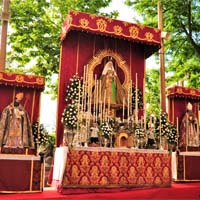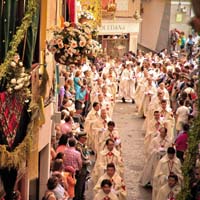Corpus Christi
The Corpus Christi of Toledo is one of the most representative religious festivities in Spain, and also in the Catholic world. It consists of a flamboyant procession that dates back to the XV century, though its exact origin is unknown. Since 1595 it has usually taken place on the Thursday after the eighth Sunday after Easter Sunday (that is, 60 days after Easter Sunday).
The Corpus Christi started taking place after Toledo’s cathedral was named Primate Cathedral, so the Diocese’s bishop is the central figure of the celebration. Other important representatives are church’s mandates, members of the brotherhoods and civil and military authorities.
Celebrations

Five weeks before the celebration takes place, the façades of the buildings around the procession’s itinerary are covered with awnings, garlands and hanging lanterns. The awnings come from the old guilds of the weavers and silk merchants. A beadle is in charge of measuring the awnings' height, so that the Monstrance can fit comfortably all along the trail of the parade. The eve of the event is a very special one: the forty-eight tapestries dating back to the XVII century hang on the outer walls of Toledo’s cathedral, and the ground is strewn with lavender, rosemary and thyme, whose scents impregnate the streets and announce the next day’s event. The warm fresh air of the summer in Spain together with the herbal scent creates a very unique atmosphere for one of the most representative religious celebrations of Spain.
Also that evening there is a small parade around the old town streets, consisting of the Tarasca (a mythological animal made of paper mâché who holds on its top a feminine figure called “Anne Boleyn”), who is accompanied by the Gigantones (giants that represent the different continents) and music bands that cheer up the spirit of the people of Toledo before the big celebration.
The next day, the procession starts at 12 o’clock, when all the bells in Toledo’s church towers start ringing at the same time. After this, and preceded by the Gigantones again, the procession comes out of the cathedral. The courtship is divided in two parts: in the first one, the newer guilds and brotherhoods march in the front. The protocol for the marching order is very strict and ruled by very antique norms. The procession is organized in two parallel lines of walkers. The second part of the procession starts with the regular and secular clergy, the primary town council, and the Monstrance. After this comes the primary archbishopric with its retinue, and after them the political and military personalities.

The Monstrance is the central part of the courtship, since it carries the Corpus Christi, in which’s honor the procession takes place. It is also the most important object kept in the Treasure chapel of Toledo’s cathedral. It was made by Enrique de Arfe, the greatest goldsmith of the XVI century, at cardinal Cisneros’ request. The Monstrance is placed on a carriage for parading it, since it weighs around 160 kilograms. It is usually received with a burst of applause by the audience as it parades through Toledo’s streets.
Another attraction can be visiting the beautiful interior courtyards of Toledo’s palaces and manors, also exuberantly decorated for the occasion, and which are open to the public on the Corpus Christi day.
Summing up, the Corpus Christi celebration of Toledo might as well be one of the rarest and most singular religious celebrations of Spain. Don't miss it if you happen to be in the area!

 The city of Toledo holds this unique procession for which the city dresses up in its finest clothes… Catch the scent of the Corpus Christi celebration!
The city of Toledo holds this unique procession for which the city dresses up in its finest clothes… Catch the scent of the Corpus Christi celebration! 